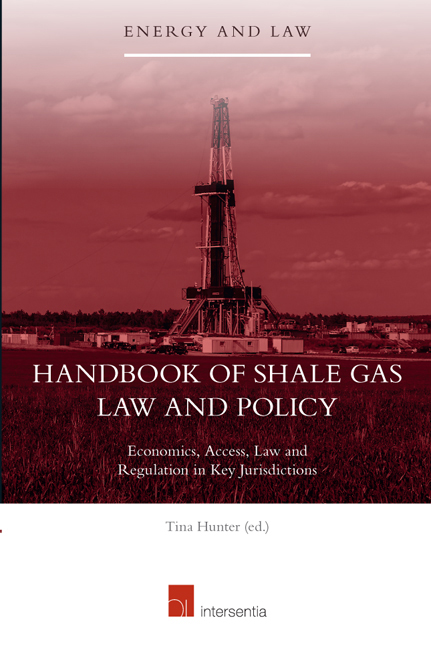Book contents
- Frontmatter
- Preface
- Contents
- List of Tables and Figures
- List of Authors
- Part I Overview and Introduction to Shale Gas Activities
- Introduction
- Shales, Shale Gas and Hydraulic Fracturing
- Hydraulic Fracturing in Shale Gas Operations: Risk and Response in Shale Gas Policy
- Part II Shale Gas Economics and Energy Security
- Part III Access to Shale Gas Resources
- Part IV Shale Gas Law and Regulation
- Part V The Future of Shale Gas in the United Kingdom
- Index
Hydraulic Fracturing in Shale Gas Operations: Risk and Response in Shale Gas Policy
from Part I - Overview and Introduction to Shale Gas Activities
Published online by Cambridge University Press: 21 September 2018
- Frontmatter
- Preface
- Contents
- List of Tables and Figures
- List of Authors
- Part I Overview and Introduction to Shale Gas Activities
- Introduction
- Shales, Shale Gas and Hydraulic Fracturing
- Hydraulic Fracturing in Shale Gas Operations: Risk and Response in Shale Gas Policy
- Part II Shale Gas Economics and Energy Security
- Part III Access to Shale Gas Resources
- Part IV Shale Gas Law and Regulation
- Part V The Future of Shale Gas in the United Kingdom
- Index
Summary
The United States has for the past several decades depended on imported fossil fuels for a substantial portion of its energy sources, but it is fast becoming one of the world's largest producers of oil and gas. Although this boom will be somewhat short-lived, particularly for oil – perhaps lasting only several decades – its impacts, both positive and negative, have spread quickly through the United States. This rather abrupt change, which took many expert geologists and economists by surprise, is the result of two oil and natural gas (‘gas’) extraction techniques: the drilling of horizontal wells through underground formations, and the pumping of large quantities of water and smaller amounts of chemicals and ‘proppants’ down these wells at high pressure to hydraulically fracture formations around them. This latter technique is called slick water or slickwater fracturing, and energy companies now extensively use slickwater fracturing in ‘unconventional’ formations around the United States. These formations include shales and tight sandstones, among other formations. Shales and tight sandstones, which formed from sediment that built up millions of years ago in marine environments, are densely packed with very low porosity (pore space) and permeability. They are also oft en found deep underground – with some of the productive shales averaging depths of more than 11,000 feet. Oil and gas are trapped within these dense, deep formations and require the use of enhanced technologies to be released from the formations.
In the late 1990s, an enterprising individual named George Mitchell perfected the combination technique of horizontal drilling and slickwater fracturing in the Barnett Shale in the northern portion of Texas in the United States. Only in the past six to seven years, however, have companies extensively applied this innovation to oil and gas-containing formations around the United States. This recent ‘revolution’, as many call it, occurred when natural gas prices rose enough to cover the higher costs of horizontal drilling and hydraulic fracturing, and when oil and gas companies realised that the technique was eff ective in a wide variety of shale and tight sandstone formations – not just in the Barnett Shale.
- Type
- Chapter
- Information
- Handbook of Shale Gas Law and PolicyEconomics, Access, Law and Regulation in Key Jurisdictions, pp. 41 - 62Publisher: IntersentiaPrint publication year: 2016



